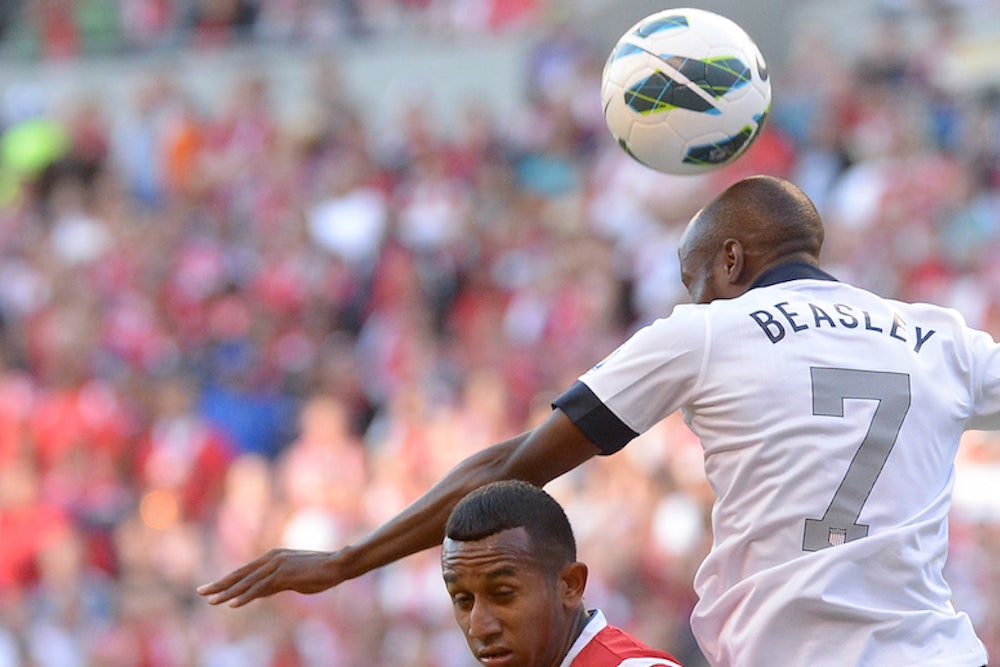With Americans thronging bars and stadiums to watch the United States play Belgium yesterday, it’s hard to remember how different the American soccer landscape looked in 1999. One could barely find soccer on television, most MLS teams played in cavernous NFL stadiums, and the U.S. men’s team had just been bombed out of the 1998 World Cup in France, winless and scoring only one goal.
If the United States wanted to compete internationally, a bold, new vision for soccer in America was a necessity. So in 1999, U.S. Soccer invited the best American youth players to join a residential academy for the under-17 men’s team in Bradenton, Florida. Modeled after European youth academies, the team would train year-round to prepare for the U-17 World Cup in Australia that year.
The inaugural Bradenton class included future U.S. national team players Kyle Beckerman, Oguchi Onyewu, and Bobby Convey. Its most famous alumnus remains Landon Donovan, who won the Golden Ball at the U-17 World Cup, prompting an ill-fated transfer to German power Bayer Leverkusen.
But few would have predicted that, of all the talent in that 1999 cohort, DaMarcus Beasley would make the greatest contribution to American soccer, playing in four consecutive World Cups.
The diminutive left-footed winger arrived on the world stage at the 2002 World Cup in South Korea and Japan. On a team anchored by American stalwarts Claudio Reyna, Brian McBride, and Eddie Pope, Bruce Arena unleashed the barely legal Beasley and Donovan on the flanks, shocking defenses with their speed, skill, and tenacity. Like two Energizer Bunnies, they just kept going.
While Donovan, sour on Europe from his time in Germany, remained in MLS, Beasley began a European odyssey that would take him from the Netherlands to England, Scotland, and Germany. On the way, he became the only American player to feature in a UEFA Champions League semi-final with PSV Eindhoven, and he continued to star for the American team, featuring under both Bruce Arena and Bob Bradley.
But with the arrival of Jurgen Klinsmann in 2011, Beasley’s spot on the American roster was not guaranteed. Needing a left-back, Klinsmann called on Beasley to learn a new position if he wanted to remain in contention for the U.S. team. Beasley said yes.
This decision exemplifies the differing mindsets of Beasley and Donovan, two players whose stories are inextricably intertwined. While Beasley bought into the Klinsmann Experiment, Donovan took a vacation to Cambodia and publicly questioned not only his commitment to U.S. Soccer but also his commitment to the sport itself. It’s an attitude that Klinsmann never accepted, and one that got Donovan cut from a U.S. team that could surely have used his skill and intelligence in Brazil.
Donovan was always the better player, but Beasley was always the one who wanted it more. When Klinsmann asks young American players to “prove it on another level,” he could also add, “Do what DaMarcus has done.”
Yesterday against Belgium, left to defend on an island against some of the best attacking wingers in the world, Beasley never buckled. His goal-line clearance was highlight reel stuff.
At a position (left-back) where the United States has been historically weak, DaMarcus Beasley became an unexpected standout of this fun-to-watch U.S. team.
With Beasley now 32, one would think that yesterday’s loss to Belgium would be his final World Cup match for the United States. But after a career like his, I wouldn’t count DMB out.
